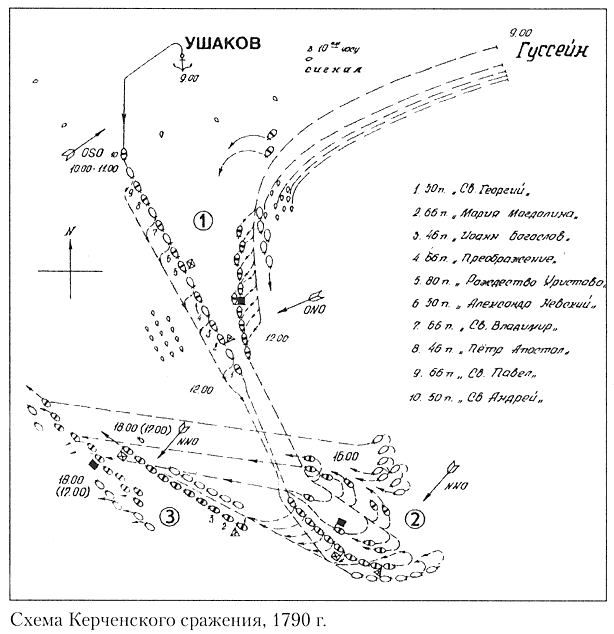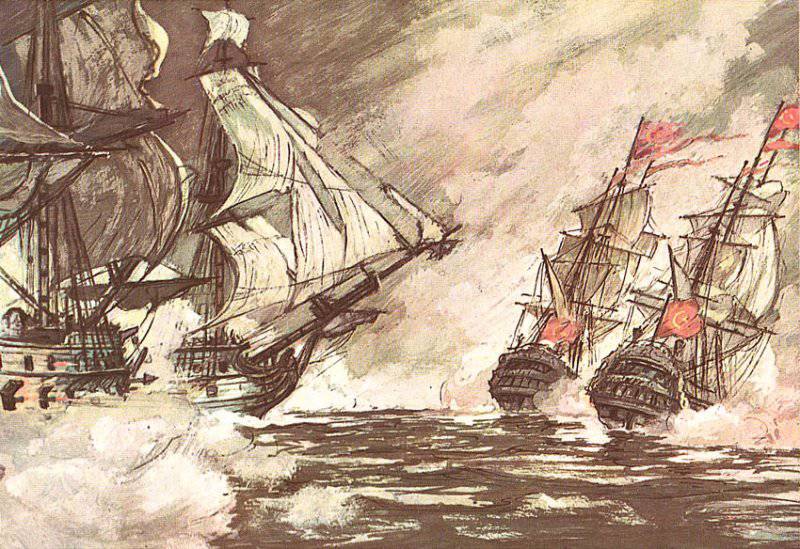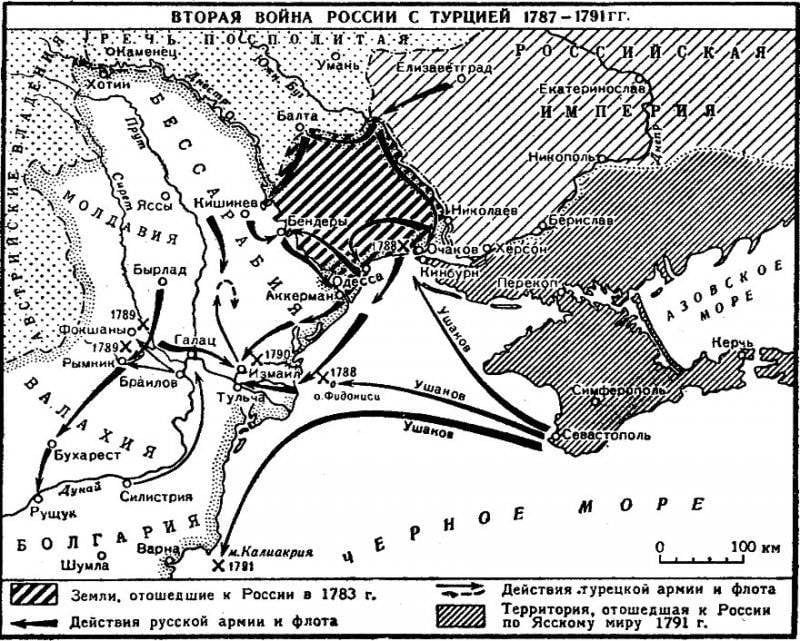8 July (19 July) 1790, the Kerch battle took place
8 July (19 July) 1790, the Kerch battle took place between the Russian and Turkish squadrons. During it, the Russian ships under the command of Rear Admiral Fyodor Fedorovich Ushakov defeated the Turkish Naval Forces and disrupted the landing of the Turkish troops on the Crimean Peninsula. This sea battle is one of the examples of the use of a new maneuverable tactic, the foundations of which were laid by the Russian naval commander Fedor Fedorovich Ushakov in the 2 half of the 18 century.
prehistory
In early May 1783, a squadron of Azov appeared in front of Akhtiar Bay, located in the southwestern part of the Crimean Peninsula flotilla. This was a detachment under the command of Vice Admiral F.A. Klokachev. Already in the same month, construction began on the city and port, which at first was called Akhtiar. In February 1784, a decree of the Russian government appeared, which officially announced the founding of the military port of Sevastopol (from the Greek. "Famous City", "The Majestic City", "City of Glory"). From that time opened story Russian Black Sea Fleet. The basis for the creation of the new fleet were the ships of the Azov flotilla. However, soon the fleet was replenished with ships built at the shipyards of Kherson. This new port city, founded near the mouth of the Dnieper in June 1778, became the main shipbuilding center in southern Russia. In 1784, the first battleship of the Black Sea Fleet was launched in Kherson. The Black Sea Admiralty was also established here.
The creation of the Black Sea Fleet went under difficult conditions: the vast territories of the Northern Black Sea Coast were at that time the remote outskirts of the empire, where they only began to develop fertile lands, build cities, build roads and create an industrial base. In order to speed up the replenishment of the Black Sea Fleet, Petersburg decided to transfer a squadron from the Baltic Sea. Six frigates left Kronstadt, made a march around Europe and reached the Dardanelles. However, the Turks refused to let the Russian ships into the Black Sea. For a whole year there were unsuccessful negotiations, but Istanbul refused to let the Russian squadron through. Port sought to prevent the strengthening of Russia on the Black Sea, to take revenge for past defeats and return the lost land, and above all the Crimean peninsula. The Turks dreamed of throwing Russia away from the Black and Azov Seas and restoring the position that existed on the southern Russian borders for several centuries.
The diplomatic struggle between the two great powers intensified with each passing year. The revanchist plans of the Turkish elite were supported by the ruling circles of France and England. London and Paris wanted to throw Russia away from the Baltic and Black Seas, to prevent the Russians from breaking into the Mediterranean. In early August, 1878, the Russian ambassador in Istanbul-Constantinople, Y. I. Bulgakov, was presented with an ultimatum in which the Turks demanded the return of the Crimean peninsula and the revision of the previously concluded agreements between St. Petersburg and Porto. The Russian ambassador rejected these insolent demands and was arrested. Such a move by the Turkish government marked the beginning of the war between the Ottoman Empire and Russia. At the same time, the Turkish fleet left the Bosphorus to the Dnieper-Bug estuary. Led the squadron "Crocodile Sea Battles" - Gassan Pasha.
The Russian fleet on the Black Sea was not ready for war. The marine infrastructure and the Black Sea fleet were at the stage of initial construction. There was a shortage of supplies, materials, weapons and ships. The Black Sea was poorly studied in terms of navigation. Turkey possessed an overwhelming superiority at sea. Only by the number of frigates did the Russian and Turkish fleets be approximately equal, for all other types of ships the Black Sea Fleet was several times inferior to the enemy. Thus, at the beginning of the war, about 20 to the Turkish battleships Russia could oppose only the 4 ship to the Black Sea theater of military operations. In addition, the Russian fleet was divided into two parts. The main core of the fleet, consisting mainly of sailing ships, was in Sevastopol. Rowing ships with a small part of sailing ships (Liman Flotilla) were based in the Dnieper-Bug estuary. Russian sailors, in order to at least somehow strengthen the Liman flotilla, had to convert Catherine II's “armada” into military ships (in 1787, the empress with a huge retinue made a journey from the capital to Tavrida, many different ships were built for her).
Prince G. Potemkin-Tavrichesky was the commander-in-chief of the land and naval forces of the South of Russia. The main task of the Russian army and navy was to defend the coast in order to prevent the enemy deep into the southern regions of the empire. One of the most vulnerable areas of defense was the region of the Dnieper-Bug estuary, where the border between Turkey and the Russian Empire was then. On the right bank of the estuary there was a powerful Turkish fortress Ochakov, which prevented the free exit of Russian ships from the Dnieper and the Southern Bug. On the opposite bank began the territory of Russia. Here, on a narrow spit opposite the Turkish coast, there was a small fortress of Kinburn, northeast of it, in 30 km from the mouth of the Dnieper - Kherson. The Turkish command concentrated here the main forces in order to seize the territory between the Bug and the Dnieper and create a springboard for further offensive on the Crimea.
War
20 August 1787, when the Black Sea Admiralty was not yet notified of the start of the war, 11 Turkish ships fired on two Russian ships stationed near Kinburn Spit (Frigate Skory and bot Bityuk). Russian ships under the command of Lieutenant Commander A. A. Obolyaninov and navigator I. F. Kuznetsov took the battle, for several hours they fought with the superior forces of the enemy. The Turks, having failed to achieve success with a sudden blow, launched a larger offensive. September 30 Turkish squadron opened fire on Kinburnu from 600 guns. 1 (12) October 1787, the Turkish ships landed troops. However, the Russian garrison under the command of Alexander Vasilyevich Suvorov destroyed most of the Turkish troops.
In the spring of 1788, the Turkish command resumed the offensive. At the entrance to the estuary, the Turks concentrated more than 100 ships with 2200 guns. The Russian Navy had only a few large sailing ships in this area and about 50 rowing vessels with 464 guns. In June, the Liman flotilla repulsed two Turkish attacks, several enemy ships were destroyed and captured. 18 June Russian fleet attacked the Turks and won a landslide victory. As a result, during 17-18 Jun, Gassan Pasha lost 15 ships, including 5 battleships and 5 frigates. The Turks lost more than 6 thousand people, including 1673 prisoners. Ochakov defeat was the hardest for the Turkish fleet since the battle of Chesma.
3 July at the island of Fidonisi, the battle of the Sevastopol squadron with the Turkish fleet took place. The Turkish fleet had a significant advantage: Gassan Pasha had 17 battleships against 2 Russian battleships, the Turks had more 1500 guns against 550 guns of the Russian squadron. Rear Admiral Voinovich was an indecisive man, and at the sight of a large Turkish fleet, he withdrew from the leadership of the squadron. The Russian squadron was headed by the commander of the avant-garde Brigadier Captain FF Ushakov. Maneuvering Ushakov was able to defeat the enemy and severely damage the Turkish flagship. The withdrawal of the Turkish flagship from the battle was for the Turks a signal for a general retreat. Shortly after the battle of Fidonisi Ushakov, he was appointed head of the Sevastopol squadron, and in March 1790 he was appointed commander of the Black Sea Fleet.
The battle of Fidonisi was of great importance. The Turks have lost complete supremacy over the sea. The Russian fleet began to make long hikes. In September 1788, a detachment of ships under the command of D. N. Senyavin reached Sinop and marched along the Turkish coast, firing at enemy strongholds. Gassan Pasha’s fleet hurried out of the Ochakovo area, the Russian fleet received complete freedom of action. In December, the fortress of Ochakov was captured, which was besieged since the summer of 1788. Russia gained an important strategic point, which covered the entire Dnieper-Bug estuary. In July 1789, the Russian army, under the command of Suvorov, won a brilliant victory at Focsani, and two months later at Rymnik.
Kerch battle
About two years after the defeat at the island of Fidonisi, the Turkish Navy did not take active steps in the Black Sea. In Turkey, the active construction of new ships. Ushakov, taking the post of commander, overcoming enormous internal difficulties, was actively engaged in strengthening the Black Sea Fleet. In July, 1789, at the confluence of the Bug and Ingul, was founded Nikolaev, where they launched the construction of ships. Subsequently, the Black Sea Admiralty was transferred to Nikolaev. In September, 1789, the Russian troops took the castle Hadzhibey, after a few years, will begin to build a harbor at this place. The new port will be called Odessa.
The Turkish command considered that the advance of the main forces of the Russian army to the Danube River would inevitably weaken the protection of coastal areas, which are located far from the theater of operations. Based on this idea, Porta decided to strike at those sections of the Russian coast where they did not expect to meet with serious resistance. The first place in these plans was occupied by the Crimean peninsula.
The Russian command was serious about the possible landing of the Turkish troops in the Crimea. Turkish troops landed on ships in Sinop and Samsun and other ports of Turkey could reach the peninsula in less than two days and land on the coast. From the Turkish fortress of Anapa, where the large garrison was located, to Kerch or Feodosiya there were generally only a few hours of progress. In Sevastopol and Kherson, they constantly received news of the preparation of the Turkish army for a landing operation. In Istanbul, a fleet was prepared for the transport of troops under the command of Hussein Pasha.
F. F. Ushakov went on a campaign in order to scout the forces of the enemy and disrupt his communications. The Russian squadron reached Sinop and went from it along the coast to Samsun, then to Anapa and returned to Sevastopol. The Russian ships captured more than ten Turkish ships, and Ushakov learned that in Constantinople there was an intensive preparation for the launch of the Turkish fleet with landing forces on board. 2 July 1790, the Russian squadron again went to sea to search for the enemy and protect the coast.
In the morning of July 8 (July 19), the Russian squadron was located opposite the Kerch Strait, between the Crimean coast and Taman. One of the cruisers said that he was observing "outside ships". Soon a large Turkish squadron was discovered, which was marching from Anapa in the direction of the Crimean Peninsula. Hussein Pasha had 10 battleships, 8 frigates and 36 auxiliary ships under his command. Ushakov had 10 battleships, 6 frigates, 1 bombing ships and 16 auxiliary ships. Although both squadrons had an equal number of battleships, Admiral Hussein Pasha was superior in strength. Under the command of the Turkish admiral there were twice as many auxiliary ships, and he had superiority in artillery weapons (1100 guns against 850 Russian cannons). In addition, the Turks occupied the windward position, which gave an advantage when maneuvering. Hussein Pasha, seeing the Russian squadron, immediately ordered to go on the attack.
At noon, the enemy fleet approached the Russian squadron at a distance of gunfire and opened fire. Hussein Pasha brought down the main attack on the Russian avant-garde, where there were two battleships and a frigate. Russian ships returned fire. A particularly fierce exchange of fire took place between the forward ships of both squadrons. Seeing that the advanced ships could not defeat the Russian avant-garde, Hussein Pasha directed the fire of other ships against him. Then Ushakov took an unexpected decision for the enemy: the Russian naval commander ordered the frigates to leave the battle line. The frigates "John the Warrior", "The Protection of the Virgin" and "Jerome" and others turned away from the line, and the battleships closed their distance tightly. Ushakov wanted the corpsial battalion (the middle part of the fleet, built to one line) could come closer to the vanguard. This maneuver contributed to the change of wind.
The Turkish admiral decided to make a turn. The Turkish squadron began to turn in order to improve its position in relation to the Russian ships. However, this maneuver only worsened the position of the Turkish fleet. At the time of the turn, the Turkish ships became even closer to the Russian ships, which were immediately intensified by the fire. The gunners of the “Nativity of Christ” battleships under the leadership of M. M. Yelchaninov’s 2 rank and “Transformation” under the command of Y. N. Sablin, 2-rank captain, especially distinguished themselves. Two enemy battleships were severely damaged, where shoots and yards were shot down. These ships even temporarily lost control. The Turkish vice admiral ship was damaged very badly. Trying to protect their damaged ships, the Turkish admiral with several ships changed course and went counter-tack parallel to the Russian squadron. Thanks to this maneuver, the Turks managed to divert the fire of the Russian squadron from previously damaged ships.
As a result of skillful maneuvering, the Russian ships were in the windward position. To take advantage of this successful moment, Fedor Ushakov gave the signal to the avant-garde turn on the tack. The flagship lay down on a new course, followed by other squadron ships taking up their positions. This unexpected and rapid rebuilding of Russian ships caused confusion among the Turks. The Turkish admiral was forced to build his line under the wind. The Russian squadron tried to get close to the Turks in order to inflict a final defeat on them. However, Hussein Pasha ordered a retreat to begin. Taking advantage of their speed and the advancing darkness, the Turkish ships fled.
At midnight, Hussein Pasha changed course and divided the fleet into two parts: the most damaged ships were sent to Sinop, and the rest of the squadron moved west. On the morning of July 9, Admiral Ushakov, not finding the enemy ships, headed for Theodosius. Three days later, the Russian squadron arrived in Sevastopol. The Turks tried to hide the defeat and reported that they sank several Russian ships. After the defeat, the Turkish fleet again took refuge in its bases, where they began to carry out intensive work on the restoration of damaged ships. The Turkish command wanted to quickly restore the combat capability of the fleet.



Information